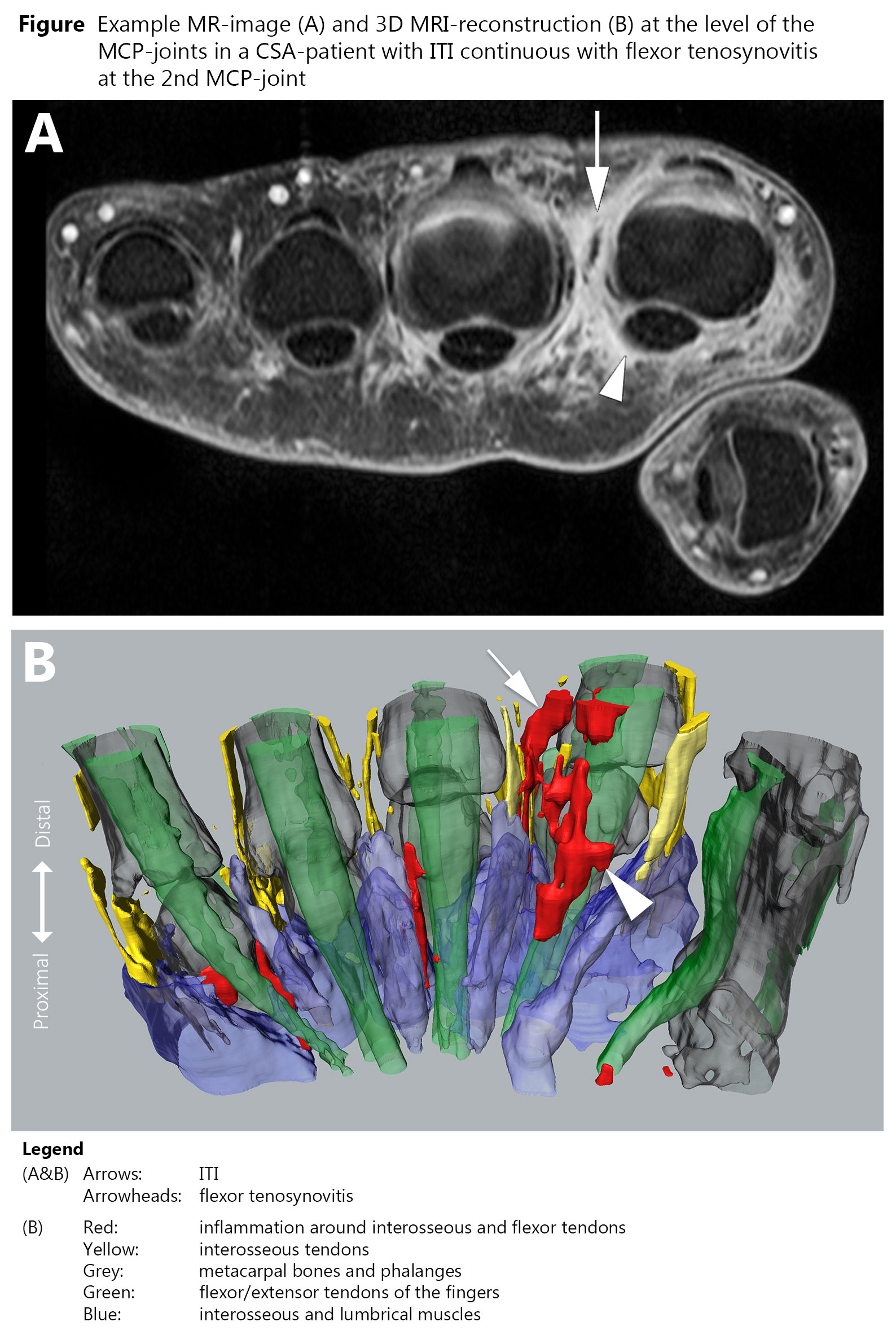Session Information
Session Type: Abstract Session
Session Time: 3:00PM-4:30PM
Background/Purpose: Inflammation around the tendons of hand interosseous muscles (interosseous tendon inflammation; ITI) on MRI was recently reported for the first time in rheumatoid arthritis (RA)-patients and ACPA-positive at-risk individuals, generating the hypothesis that ITI precedes clinical arthritis. To better understand the role of ITI during RA-development, we compared the frequency of ITI in clinically suspect arthralgia (CSA) to the general population and investigated the relation of ITI with other locally inflamed tissues (synovitis/tenosynovitis/osteitis), symptoms and future arthritis development.
Methods: 667 consecutive patients presenting with CSA and 193 symptom-free controls from the general population underwent contrast-enhanced hand-MRI. MRIs were evaluated for ITI at the ulnar and radial sides of MCP2-5, and for synovitis/tenosynovitis/osteitis using the rheumatoid arthritis MRI scoring system (RAMRIS). CSA-patients were followed on clinical arthritis development (median follow-up 25 months). Logistic and Cox-regression were used. ACPA-stratification was performed.
Results: At presentation, 10% of CSA-patients had ITI, compared to 1% of symptom-free controls (p < 0.001). ITI was more frequent in ACPA-positive than ACPA-negative CSA (27% versus 7%; p < 0.001). Synovitis and tenosynovitis at MCPs associated independently with ITI-presence (OR 2.2 (95%CI 1.2-4.2) and 9.7 (5.5-17.0), respectively). 3D MRI-reconstruction indicated that ITI is continuous with MCP flexor tenosynovitis (Figure). Although CSA-patients with ITI more often had local MCP-tenderness(1.6(1.03-2.4)), difficulties making a fist(1.6(0.98-2.7)) and reduced hand-functioning(β 0.20(0.05-0.36)), multivariable analyses showed that these symptoms were explained by co-occurring (teno)synovitis. CSA-patients with ITI developed clinical arthritis more frequently than those without (HR 4.5 (2.8-7.2)); this relation was stronger in ACPA-negative (3.9 (1.9-7.9)) than ACPA-positive CSA (1.8 (0.9-3.4)).
Conclusion: ITI is almost absent in the general population but occurs in CSA, where it precedes clinical arthritis. The strong relation with tenosynovitis evokes the question whether ITI represents true peritendonitis or juxta-articular synovial inflammation.
To cite this abstract in AMA style:
van Dijk B, van Steenbergen H, Reijnierse M, Khidir S, Wisse L, deRuiter M, van der Helm-van Mil A. Interosseous Tendon Inflammation in the Hands: A Novel Feature of Developing Rheumatoid Arthritis? Results from a Large MRI Study in Clinically Suspect Arthralgia [abstract]. Arthritis Rheumatol. 2022; 74 (suppl 9). https://acrabstracts.org/abstract/interosseous-tendon-inflammation-in-the-hands-a-novel-feature-of-developing-rheumatoid-arthritis-results-from-a-large-mri-study-in-clinically-suspect-arthralgia/. Accessed .« Back to ACR Convergence 2022
ACR Meeting Abstracts - https://acrabstracts.org/abstract/interosseous-tendon-inflammation-in-the-hands-a-novel-feature-of-developing-rheumatoid-arthritis-results-from-a-large-mri-study-in-clinically-suspect-arthralgia/

